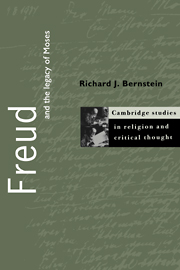Book contents
- Frontmatter
- Contents
- Preface
- List of abbreviations
- 1 The Egyptian origin of monotheism and the murder of Moses
- 2 Tradition, trauma, and the return of the repressed
- 3 Anti-Semitism, Christianity, and Judaism
- 4 “Dialogue” with Yerushalmi
- Appendix: an exchange of letters between Sigmund Freud and Lou Andreas-Salomé
- Notes
- Bibliography
- Index
2 - Tradition, trauma, and the return of the repressed
Published online by Cambridge University Press: 15 December 2009
- Frontmatter
- Contents
- Preface
- List of abbreviations
- 1 The Egyptian origin of monotheism and the murder of Moses
- 2 Tradition, trauma, and the return of the repressed
- 3 Anti-Semitism, Christianity, and Judaism
- 4 “Dialogue” with Yerushalmi
- Appendix: an exchange of letters between Sigmund Freud and Lou Andreas-Salomé
- Notes
- Bibliography
- Index
Summary
“THE MOST IMPORTANT PART OF THE STORY”
The stylistic structure of the final version of The Man Moses and the Monotheistic Religion is extremely awkward and confusing. Freud, who took special pride in his style, deplored its “inartistic quality” but found himself “unable to wipe out the traces of the history of the work's origin, which was in any case unusual” (23:103). The first two parts consist of unrevised versions of the two essays that he had previously published in Imago. The third essay (which is almost twice as long as the first two essays together) begins with the two “contradictory” prefaces – the first written before the Anschluss in March 1938, and the second preface written in England shortly after his arrival in June 1938. The main body of this third essay is itself divided into two parts. The first part consists of five sections which have the following titles: (A) The Historical Premiss; (B) The Latency Period and Tradition; (C) The Analogy; (D) Application; (E) Difficulties. Part II begins with a section entitled “Summary and Recapitulation,” which reads like still another (a third) preface. This is then followed by nine sections: (A) The People of Israel; (B) The Great Man; (C) The Advance in Intellectuality; (D) Renunciation of Instinct; (E) What is True in Religion; (F) The Return of the Repressed; (G) Historical Truth; (H) The Historical Development.
This schematic outline indicates the variety of topics that Freud discusses, and the way in which Freud shuttles between historical and psychoanalytic themes.
- Type
- Chapter
- Information
- Freud and the Legacy of Moses , pp. 27 - 74Publisher: Cambridge University PressPrint publication year: 1998

